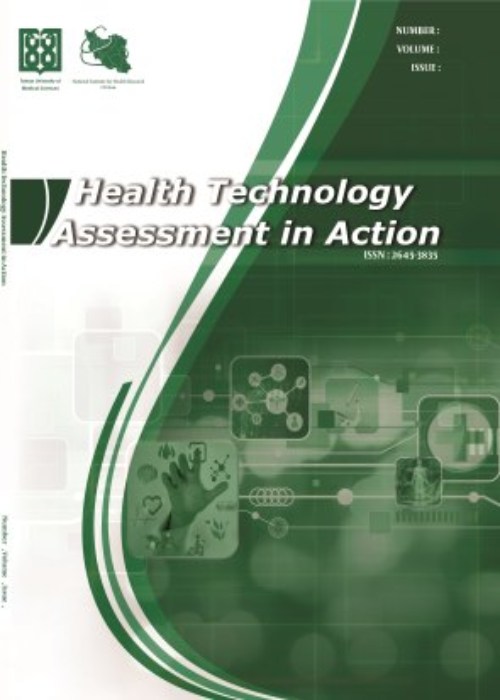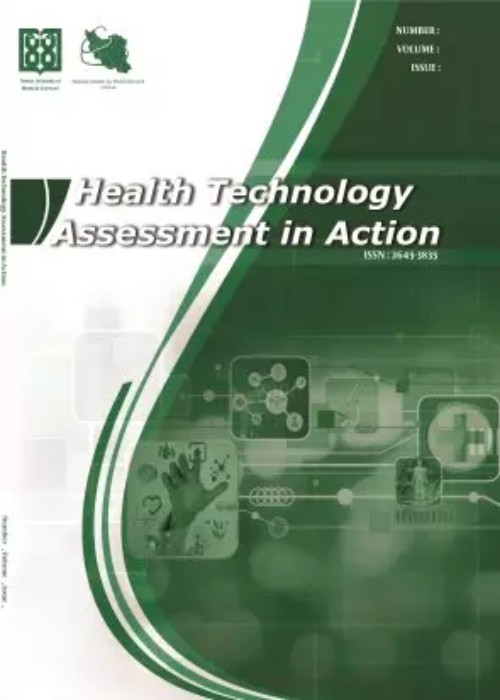فهرست مطالب

Health Technology Assessment in Action
Volume:7 Issue: 1, Nov 2023
- تاریخ انتشار: 1402/04/26
- تعداد عناوین: 5
-
-
Page 1
Today, with the advent of science and technology, societies are moving towards becoming complex and specialized; therefore, knowledge should be considered the basis of development and social welfare of countries. Meanwhile, the role of managers of educational and research centers of universities who have management skills is very important. The present study was conducted with the aim of studying the role of three managerial skills in designing the competency model of education managers of Khorasan Razavi Islamic Azad University branches. This research is applied in terms of its objective and exploratory-mixed in terms of its methodology (qualitative-quantitative). The statistical population of the research in the qualitative part included university experts with related expertise, who were included in the study through targeted sampling. The data collection method was library and measurement tools were a semi-structured interview in the qualitative part and a researcher-made questionnaire in the quantitative part, the questions of which were taken from the data obtained from the interview. In the quantitative part, the statistical population included 951 employees of Khorasan Razavi Islamic Azad University branches, of which 274 were selected randomly. The findings showed that 75% of the competence of education managers of Khorasan Razavi Islamic Azad University branches depends on the dimensions of management skills, namely the three technical, human, and perceptual dimensions. These dimensions can explain and predict the competence of education managers, who have seven dimensions as follows: individual characteristics, organizational factors, entrepreneurial competence, business competence, leadership, decision-making, and cooperation. Also, it was suggested that Islamic Azad University should act step by step and gradually according to a road map and long-term strategic plan in order to realize these concepts. To this end, it is necessary to formulate an operational plan and adopt a paradigmatic approach with a local and regional perspective.
Keywords: Competencies, The Competence of Managers, Managerial Skills, Islamic Azad University Branches -
Page 2Background
One of the centers that provide health services and treatment for HIV/AIDS patients is behavioral disease counseling centers. Today, patient safety and treatment combined with compliance with ethical and legal standards are among the most important concerns of medical and health centers, including the most important criteria for the credibility of an institution. In the meantime, medication errors in HIV/ AIDS patients lead to treatment disruption, drug poisoning, or even death. Considering the importance of the subject, the present research was conducted to identify and explain the factors affecting the management of medication errors in HIV/AIDS patients in Iran's health system.
MethodsThe present study is an applied study that was performed by descriptive method. First, by reviewing the research literature and interviewing 35 experts in the field of HIV / AIDS treatment, the variables and main components affecting the management of medication errors in HIV / AIDS patients were extracted and a research questionnaire was designed using them. Data were collected from 400 experts and specialists in infectious diseases, etc. Then, the collected data were analyzed using structural equation modeling, and SPSS23 software and LISREL software.
ResultsFour factors were identified as effective factors in medication error management in HIV/AIDS patients: organizational, educational, individual, and communication factors. Organizational factors and communication factors with a factor loading of 0.763 and 0.646 had the highest and lowest impact on drug error management in HIV / AIDS patients, respectively.
ConclusionTo efficiently and effectively manage medication errors in HIV / AIDS patients, while considering all four factors, organizational and educational factors should be given more attention and emphasis by managers.
Keywords: HIV, AIDS, Medication Error Management, Patient Safety, Structural Equation Modeling, Exploratory Factor Analysis -
Page 3Background
A healthy, clean, and secure environment is necessary for the hospital, one of the fundamental foundations of the nation’s healthcare system, to function well and sustain the general well-being of society. Timely detection of contaminated surfaces and efficient and timely disinfection will be helpful in hospital infection control.
ObjectivesThe level of surface contamination of medical equipment in intensive care units was to be determined and compared as part of this research.
MethodsUsing standard microbial culture and nanosensors, the current study was conducted descriptively over one month, with a sample size of 400 cases on ten different types of medical equipment.
ResultsThe findings showed that 66% of samples acquired using the nanosensor and 54.5% obtained using the culture medium were clean, and the rest were contaminated. The most prevalent microbes were also identified as E. coli, Staphylococcus aureus, and salmonella, with 55.68%, 28.9%, and 23.86%, respectively.
ConclusionsBoth methods have the necessary precision to identify contamination reservoirs, and the contamination reported in both methods is similar to what was expected. So nanosensors can be utilized as a quick, precise, and affordable method when the aim is to identify the overall contamination rather than to differentiate between different types of bacteria.
Keywords: Hospital Infection, Healthcare-Associated Infections, Nanotechnology, Infection Control, Indicators, Reagents -
Page 4Background
Considering the expansion of friendship between boys and girls during adolescence, as an abnormal behavior in our society and the important role of communication patterns in the family, it is important to investigate the effect of mediating variables on this social phenomenon. The present research has investigated the model of communication with the opposite sex among teenage girls in Birjand city under the influence of communication patterns in the family and the mediating variable of assertiveness.
MethodsThis is a correlational study. Sample size was 360 female students of Birjand city. Sampling method was multi-stage cluster random sampling. The data collection tool was a set of questionnaires. We use correlational analysis methods and Structural Equation Model to interpret data.
ResultsThe fitted model showed communication patterns of family has a significant effect on the relationship with the opposite sex through mediating variable.
Conclusionthe communication pattern of dialogue alone does not play a role in the relationship with the opposite sex, but with increasing assertiveness; it decreases the relationship with the opposite sex.
Keywords: Assertiveness, Family Communication Patterns, Opposite Sex, Teenage Girls -
Page 5Background
Failure to evaluate, examine, assess the requirements, and determine the quality level of the curriculum of educational fields will result in low-quality and obsolete curricula. It will prevent the academic areas from achieving their goals. Therefore, this study evaluates the overall quality of Iran's Health Technology Assessment (HTA) curriculum from the perspectives of instructors and students.
MethodsThe study was conducted with 127 instructors, students, and Health Technology Assessment (HTA) graduates at Tehran, Iran, Kerman, and Yazd Universities of Medical Sciences. A researcher-made questionnaire did the data collection. Cronbach's alpha coefficient for the entire questionnaire was 91%, and the intra-domain correlation coefficient was 87%, indicating that the instrument is appropriate. The data were analyzed with descriptive and analytical tests based on the normality or non-normality of the test using ANOVA, Kruskal-Wallis, two-way ANOVA, and the Friedman.
ResultsThis research was completed by 114 of 127 participants. According to a review of diverse perspectives, the quality of the educational program in terms of design elements in special courses and executive elements in compensatory courses falls within the range of average (3.66 > mean > 2.33) or average (3.66 > mean > 2.33), to good (mean > 2.33). In addition, the majority of executive elements from special courses and design elements from compensatory classes are in an unfavorable position, with a mean>1.66 to average (3.66> mean >2.33).
ConclusionsProblems and inadequacies are observed in a few curriculum implementation elements. Therefore, modifications should be made to remedy the inappropriate details and remove implementation obstacles to enhance the interested groups' capability and practical skills.
Keywords: Health Technology Assessment (HTA), Educational Program, Evaluation


